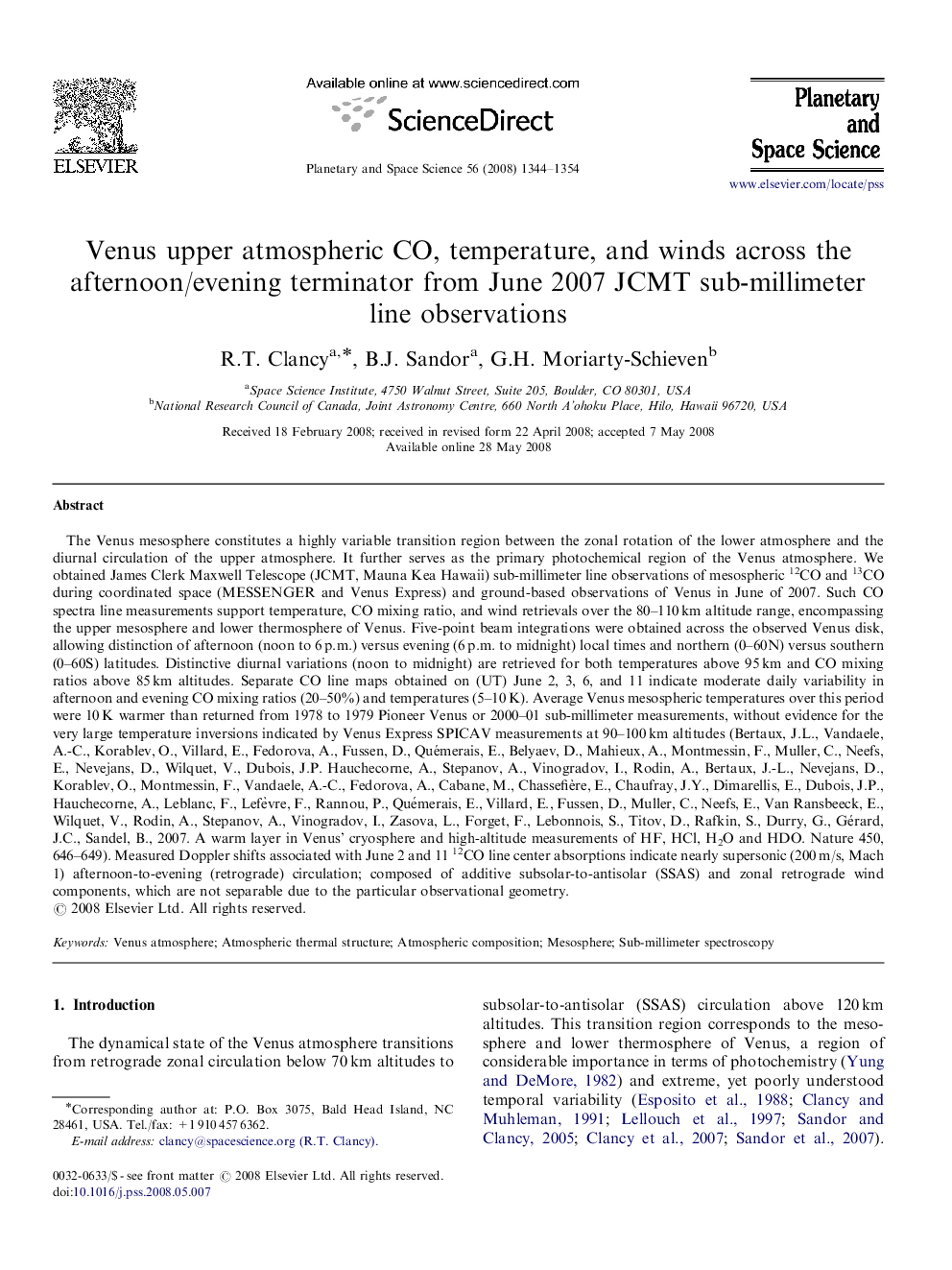| Article ID | Journal | Published Year | Pages | File Type |
|---|---|---|---|---|
| 1782600 | Planetary and Space Science | 2008 | 11 Pages |
The Venus mesosphere constitutes a highly variable transition region between the zonal rotation of the lower atmosphere and the diurnal circulation of the upper atmosphere. It further serves as the primary photochemical region of the Venus atmosphere. We obtained James Clerk Maxwell Telescope (JCMT, Mauna Kea Hawaii) sub-millimeter line observations of mesospheric 12CO and 13CO during coordinated space (MESSENGER and Venus Express) and ground-based observations of Venus in June of 2007. Such CO spectra line measurements support temperature, CO mixing ratio, and wind retrievals over the 80–110 km altitude range, encompassing the upper mesosphere and lower thermosphere of Venus. Five-point beam integrations were obtained across the observed Venus disk, allowing distinction of afternoon (noon to 6 p.m.) versus evening (6 p.m. to midnight) local times and northern (0–60N) versus southern (0–60S) latitudes. Distinctive diurnal variations (noon to midnight) are retrieved for both temperatures above 95 km and CO mixing ratios above 85 km altitudes. Separate CO line maps obtained on (UT) June 2, 3, 6, and 11 indicate moderate daily variability in afternoon and evening CO mixing ratios (20–50%) and temperatures (5–10 K). Average Venus mesospheric temperatures over this period were 10 K warmer than returned from 1978 to 1979 Pioneer Venus or 2000–01 sub-millimeter measurements, without evidence for the very large temperature inversions indicated by Venus Express SPICAV measurements at 90–100 km altitudes (Bertaux, J.L., Vandaele, A.-C., Korablev, O., Villard, E., Fedorova, A., Fussen, D., Quémerais, E., Belyaev, D., Mahieux, A., Montmessin, F., Muller, C., Neefs, E., Nevejans, D., Wilquet, V., Dubois, J.P. Hauchecorne, A., Stepanov, A., Vinogradov, I., Rodin, A., Bertaux, J.-L., Nevejans, D., Korablev, O., Montmessin, F., Vandaele, A.-C., Fedorova, A., Cabane, M., Chassefière, E., Chaufray, J.Y., Dimarellis, E., Dubois, J.P., Hauchecorne, A., Leblanc, F., Lefèvre, F., Rannou, P., Quémerais, E., Villard, E., Fussen, D., Muller, C., Neefs, E., Van Ransbeeck, E., Wilquet, V., Rodin, A., Stepanov, A., Vinogradov, I., Zasova, L., Forget, F., Lebonnois, S., Titov, D., Rafkin, S., Durry, G., Gérard, J.C., Sandel, B., 2007. A warm layer in Venus’ cryosphere and high-altitude measurements of HF, HCl, H2O and HDO. Nature 450, 646–649). Measured Doppler shifts associated with June 2 and 11 12CO line center absorptions indicate nearly supersonic (200 m/s, Mach 1) afternoon-to-evening (retrograde) circulation; composed of additive subsolar-to-antisolar (SSAS) and zonal retrograde wind components, which are not separable due to the particular observational geometry.
